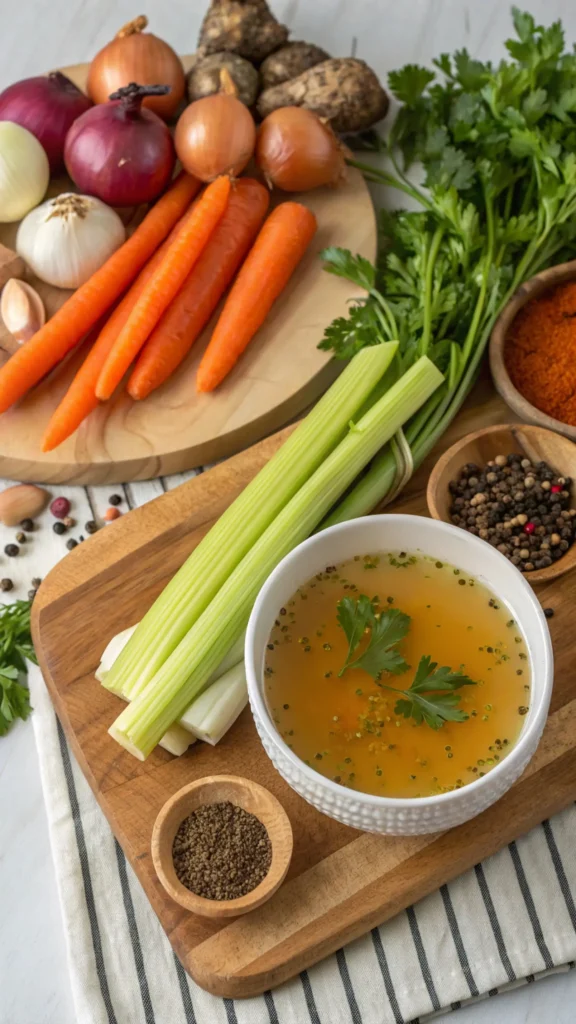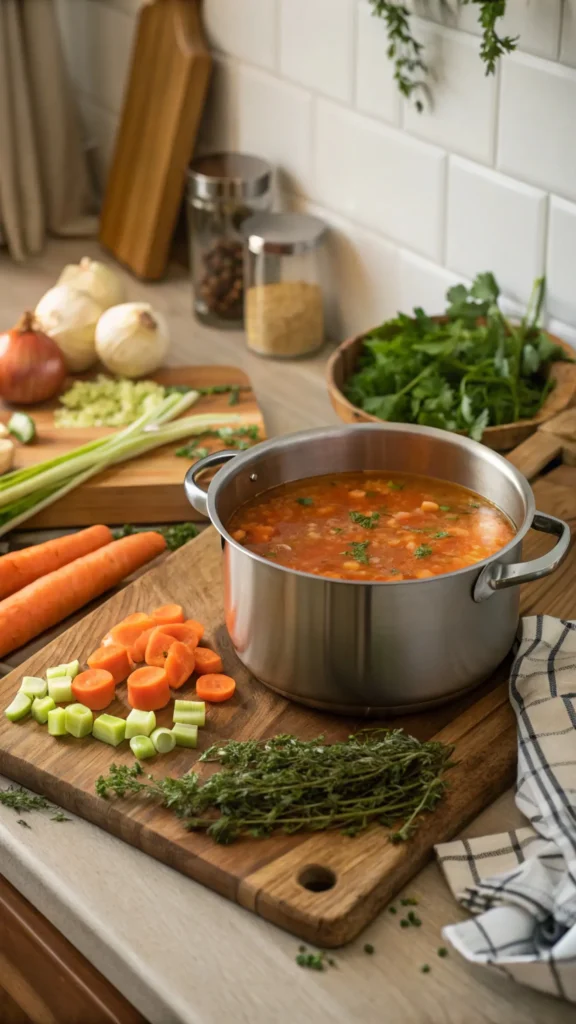There’s something undeniably comforting about a warm bowl of soup, especially on a chilly day. Not only does it nourish the body, but it also soothes the soul. In fact, a bowl of soup can be the perfect remedy for a long day or a simple way to enjoy fresh, seasonal ingredients. Moreover, this versatile dish allows you to get creative with flavors and textures, making it suitable for any palate. Whether you prefer a hearty vegetable medley or a creamy blend, making your own soup at home is both satisfying and rewarding. So, gather your fresh vegetables, spices, and herbs, and let’s dive into the delightful world of soup-making!
Table of Contents
Table of Contents

bowl of soup
Equipment
- 1 Large Pot For cooking the soup.
- 1 immersion blender Optional for blending the soup.
Ingredients
Fresh Vegetables
- 2 cups carrots, chopped Adds sweetness and texture.
- 2 cups celery, chopped Provides a crunchy base.
- 1 cup onion, chopped Essential for flavor.
Broth
- 4 cups vegetable or chicken broth Choose based on preference.
Spices and Herbs
- 1 teaspoon salt To taste.
- 1 teaspoon pepper To taste.
- 1 teaspoon paprika or cumin Optional for added flavor.
Herbs
- 1 tablespoon fresh thyme Adds brightness.
- 1 tablespoon fresh parsley For garnish.
Protein Alternatives
- 1 cup beans or lentils For added protein.
- 1 cup tofu, cubed Optional for heartiness.
Instructions
Gather Your Ingredients
- Start by collecting fresh vegetables like carrots, celery, and onions. Additionally, choose a flavorful broth—vegetable or chicken works well. Don’t forget your spices and herbs for that extra kick!
Sauté Aromatics
- In a large pot, heat a splash of olive oil over medium heat. Add chopped onions, garlic, and any other aromatics. Sauté them for about 3-5 minutes until they become fragrant and translucent.
Add Vegetables
- Next, toss in your chopped vegetables. Stir them well, allowing them to cook for another 5 minutes. This step builds a solid flavor base for your bowl of soup.
Pour in the Broth
- Now, add your broth to the pot. Bring it to a gentle boil, then reduce the heat to a simmer. This allows the flavors to meld beautifully.
Season to Taste
- After about 15-20 minutes of simmering, taste your soup. Add salt, pepper, and any other spices you prefer. Remember, seasoning is key to a flavorful bowl of soup!
Blend for Creaminess (Optional)
- If you desire a creamy texture, use an immersion blender to blend part of the soup. Alternatively, transfer a portion to a blender, then return it to the pot.
Final Touches
- Allow the soup to simmer for an additional 5 minutes. This step ensures everything is heated through and flavors are well combined.
Serve and Enjoy
- Ladle your warm soup into bowls. Garnish with fresh herbs, a dollop of yogurt, or a sprinkle of cheese. Pair it with crusty bread or crunchy crackers for a complete meal!
Notes
| Calories | Fat | Protein | Carbs |
|---|---|---|---|
| 250 | 5g | 10g | 40g |
Key Benefits
When you think of a cozy bowl of soup, what comes to mind? For many, it’s the ultimate comfort food that warms both the body and soul. Here are some key benefits of enjoying a bowl of soup:
- Nourishment: A bowl of soup can be packed with essential nutrients. By using fresh vegetables and wholesome ingredients, you’re giving your body a nutrient-rich meal that fuels your day.
- Comfort Food: There’s something undeniably soothing about a warm bowl of soup. It’s like a hug in a bowl, especially on chilly days.
- Easy Meal: If you’re short on time, a bowl of soup is an easy meal option. You can whip it up quickly, making it perfect for busy weeknights.
- Versatility: You can customize your bowl of soup to suit any dietary need. Whether you’re vegetarian, vegan, or gluten-free, there’s a soup recipe for you.
- Warmth: On a cold day, nothing beats the warmth of a steaming bowl of soup. It’s a simple pleasure that can brighten your mood.
So, the next time you crave a bowl of soup, remember these benefits. Not only is it delicious, but it’s also a healthful choice that brings comfort and nourishment to your table.
Ingredients for Your Cozy Bowl of Soup
Creating the perfect bowl of soup starts with selecting the right ingredients. Each component plays a vital role in building flavor and nourishment. Here’s what you’ll need:
- Fresh Vegetables: Carrots, celery, and onions are classic choices. They provide a solid base and add natural sweetness. Feel free to include seasonal vegetables like zucchini or spinach for added nutrition.
- Broth: Choose between vegetable or chicken broth, depending on your preference. A rich, flavorful broth is essential for a comforting bowl of soup.
- Spices: Don’t shy away from spices! A pinch of salt, pepper, and perhaps a dash of paprika or cumin can elevate your soup. Experiment with spices to find your perfect blend.
- Herbs: Fresh herbs like thyme, parsley, or basil add brightness. Alternatively, dried herbs can work well, too. Just remember to adjust the quantity, as dried herbs are more concentrated.
- Protein Alternatives: For a heartier soup, consider adding beans, lentils, or tofu. These ingredients not only boost protein but also enhance the soup’s texture.

As you gather your ingredients, remember that the quality of each item matters. Fresh vegetables and a good broth will significantly impact the final flavor of your bowl of soup. So, take your time and choose wisely!
How to Make a Bowl of Soup
Creating a cozy bowl of soup is not only satisfying but also quite simple. Follow these easy steps to whip up a delicious and nourishing meal in no time!
- Gather Your Ingredients: Start by collecting fresh vegetables like carrots, celery, and onions. Additionally, choose a flavorful broth—vegetable or chicken works well. Don’t forget your spices and herbs for that extra kick!
- Sauté Aromatics: In a large pot, heat a splash of olive oil over medium heat. Add chopped onions, garlic, and any other aromatics. Sauté them for about 3-5 minutes until they become fragrant and translucent.
- Add Vegetables: Next, toss in your chopped vegetables. Stir them well, allowing them to cook for another 5 minutes. This step builds a solid flavor base for your bowl of soup.
- Pour in the Broth: Now, add your broth to the pot. Bring it to a gentle boil, then reduce the heat to a simmer. This allows the flavors to meld beautifully.
- Season to Taste: After about 15-20 minutes of simmering, taste your soup. Add salt, pepper, and any other spices you prefer. Remember, seasoning is key to a flavorful bowl of soup!
- Blend for Creaminess (Optional): If you desire a creamy texture, use an immersion blender to blend part of the soup. Alternatively, transfer a portion to a blender, then return it to the pot.
- Final Touches: Allow the soup to simmer for an additional 5 minutes. This step ensures everything is heated through and flavors are well combined.
- Serve and Enjoy: Ladle your warm soup into bowls. Garnish with fresh herbs, a dollop of yogurt, or a sprinkle of cheese. Pair it with crusty bread or crunchy crackers for a complete meal!

By following these steps, you’ll have a delightful bowl of soup ready to warm your soul. Enjoy the process and feel free to customize it to your taste!
Pro Tips, Variations, and Common Problems
Creating the perfect bowl of soup is an art, and with a few insider tips, you can elevate your dish to new heights. Here are some pro tips to keep in mind:
- Ingredient Substitutions: If you’re out of a specific vegetable, don’t fret! You can swap in whatever you have on hand. For instance, use sweet potatoes instead of regular potatoes or kale instead of spinach. This flexibility allows you to create a unique bowl of soup every time.
- Thickening Agents: If your soup turns out too thin, consider adding a thickening agent. Pureed beans or lentils work wonders. Alternatively, mix a tablespoon of cornstarch with cold water and stir it into the soup. This will help achieve that desired creamy texture.
- Balancing Flavors: Taste as you go! If your soup is too salty, add a splash of vinegar or a bit of sugar to balance the flavors. On the other hand, if it’s bland, a pinch of salt or a squeeze of lemon can brighten it up.
- Storage Tips: To keep your bowl of soup fresh, store it in airtight containers. It can last up to three days in the fridge or be frozen for longer shelf life. Just remember to cool it completely before freezing!
- Common Problems: If you find your vegetables are undercooked, simply let the soup simmer a bit longer. Conversely, if they’re overcooked, try adding fresh herbs or a squeeze of lemon juice to refresh the flavors.
Additionally, don’t hesitate to get creative with your bowl of soup. Here are some delightful variations:
- Spicy Twist: Add a dash of cayenne pepper or a spoonful of sriracha for a spicy kick.
- Herb Infusion: Experiment with different herbs like thyme, rosemary, or basil to change the flavor profile.
- Protein Boost: For a heartier soup, consider adding cooked chicken, tofu, or chickpeas. This not only enhances the nutrition but also makes your bowl of soup more filling.
In conclusion, making a bowl of soup can be a rewarding experience. With these tips and variations, you’ll not only troubleshoot common issues but also create a comforting dish that warms the soul. Enjoy your cooking adventure!
Serving Suggestions for Your Bowl of Soup
When it comes to serving a cozy bowl of soup, tradition plays a significant role. A bowl of soup is often enjoyed as a comforting meal, especially during colder months. Here are some delightful serving suggestions to elevate your soup experience:
- Garnishes: Consider adding fresh herbs like parsley or cilantro for a burst of color and flavor. A dollop of yogurt or sour cream can also enhance creaminess, while a sprinkle of cheese adds a savory touch.
- Accompaniments: Pair your bowl of soup with crusty bread or crunchy crackers. This not only adds texture but also makes for a satisfying meal. For a more filling option, serve it alongside a simple salad.
- Presentation: The visual appeal of your bowl of soup matters. Use vibrant bowls to showcase the colors of your ingredients. Additionally, a drizzle of olive oil or a sprinkle of chili flakes can create an inviting look.
- Temperature: Serve your soup hot, as warmth enhances its comforting qualities. You can preheat your bowls to keep the soup warm longer, ensuring every spoonful is enjoyed at the perfect temperature.
- Seasonal Touch: Depending on the season, consider adding seasonal ingredients as garnishes. For instance, in the fall, roasted pumpkin seeds can add a delightful crunch, while in spring, fresh peas or microgreens can brighten up the dish.
Ultimately, a bowl of soup is not just a meal; it’s an experience. By thoughtfully considering these serving suggestions, you can impress your guests and create a warm, inviting atmosphere that celebrates the joy of sharing food.
Preserving and Reheating Your Cozy Bowl of Soup
To keep your bowl of soup tasting fresh and delicious, proper storage is essential. First, allow your soup to cool completely before transferring it to an airtight container. This step is crucial because it prevents condensation, which can lead to spoilage. You can store your soup in the refrigerator for up to three days. If you want to keep it longer, consider freezing it. In fact, most soups can be frozen for up to three months without losing their flavor or texture. For optimal freshness, use vacuum-sealing bags or freezer-safe containers, as these methods help prevent freezer burn.
When storing soup, always label your containers with the date. This way, you can easily track how long it has been stored. Additionally, remember to practice food safety by ensuring your soup is heated to at least 165°F (74°C) before consuming it again. This temperature helps eliminate any potential bacteria that may have developed during storage.
Reheating Methods
Now that you know how to store your soup, let’s talk about reheating it to perfection. The stovetop is often the best method for reheating a bowl of soup, as it allows for even heating. Start by pouring your soup into a saucepan and heat it over medium-low heat. Stir occasionally to ensure it warms evenly. If the soup appears too thick, simply add a splash of broth or water to restore its original consistency.
If you’re short on time, the microwave is a convenient option. Pour your soup into a microwave-safe bowl, cover it with a microwave-safe lid or plate, and heat it in one-minute intervals, stirring in between. This method helps prevent hot spots and ensures even heating. However, be cautious not to overheat, as this can lead to a loss of flavor and texture.
For those who enjoy a crispy finish, consider using an air fryer. Pour your soup into an oven-safe dish and heat it at 350°F (175°C) for about 10-15 minutes. This method can give your soup a unique texture, especially if it has toppings like cheese or croutons. Regardless of the method you choose, always taste your soup before serving. You may want to adjust the seasoning by adding a pinch of salt or a dash of pepper to refresh the flavors.
In summary, with the right storage and reheating techniques, you can enjoy your cozy bowl of soup just as much as when it was first made. So, go ahead and savor every spoonful, knowing you’ve preserved its deliciousness!
Conclusion
As you wrap up your cooking adventure, remember that a cozy bowl of soup is not just a meal; it’s a comforting experience that brings nourishment and warmth to your day. This recipe is wonderfully simple and versatile, making it an excellent choice for both novice cooks and seasoned chefs alike. I encourage you to give it a try and savor the delightful flavors you create. Don’t hesitate to share your thoughts or any questions you might have in the comments below!
Moreover, feel free to experiment with different ingredients or pairings to make this bowl of soup uniquely yours. Whether you add a splash of cream, a handful of fresh herbs, or even a sprinkle of your favorite spices, the possibilities are endless. Cooking is meant to be fun, and this soup is a perfect canvas for your creativity. So, roll up your sleeves, enjoy the process, and let the delicious aroma fill your kitchen!
Lastly, I’d love to see how your soup turns out! Share your results or any variations you tried. Remember, each bowl of soup tells a story, and I can’t wait to hear yours. Happy cooking!
FAQs About Your Cozy Bowl of Soup
Here are some common questions you might have while making your perfect bowl of soup. Let’s dive in!
1. How do I store leftover soup?
To store your leftover bowl of soup, allow it to cool completely. Then, transfer it to an airtight container. You can keep it in the refrigerator for up to three days. Alternatively, if you want to save it for longer, consider freezing it. Just remember to leave some space in the container for expansion!
2. Can I substitute ingredients in my soup?
Absolutely! Ingredient substitutions can enhance your bowl of soup. For instance, if you don’t have chicken broth, vegetable broth works just as well. Additionally, if you’re looking for a creamier texture, try using coconut milk instead of dairy. Be creative and adjust based on what you have on hand!
3. How can I thicken my soup?
If your bowl of soup is too thin, there are several ways to thicken it. You can add a slurry made from cornstarch and water. Alternatively, pureeing a portion of the soup can create a thicker consistency. Lastly, adding cooked rice or beans can also help achieve that desired thickness.
4. What vegetables work best in soup?
When it comes to vegetables, you have plenty of options! Carrots, celery, and onions are classic choices. However, you can also add seasonal vegetables like zucchini or spinach for added nutrition. Just remember to chop them into uniform sizes for even cooking!
5. How do I reheat my soup without losing flavor?
To reheat your bowl of soup without losing flavor, do so gently on the stove over medium heat. Stir occasionally to ensure even heating. If the soup seems too thick after refrigeration, add a splash of broth or water to restore its original consistency. Enjoy your warm, flavorful soup!
Your Flavorful Feedback
There are no reviews yet. Be the first one to write one.

